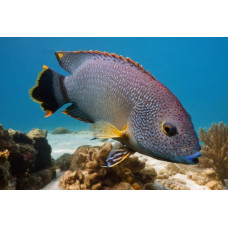Latin name
Cheilinus trilobatus
Other name
Cheilinus trilobatus
Identification
Tripletail wrasses have a moderately deep body and a three-lobed tail. The dorsal profile of the head is convex. The anterior tip of the snout forms an acute angle. The jaws are prominent with 2 strong canines on each anterior jaw. There are no enlarged teeth on the back of the upper jaw. The lateral line is interrupted below the posterior part of the dorsal fin base, with a total of 22-23 porous scales. The scales extend to the base of the dorsal and anal fins.
Features of fish fins
Dorsal spines (total): 9; Dorsal soft rays (total): 10; Anal spines: 3; Anal soft rays: 8.
The pelvic fins are long, reaching the anus in juveniles and much longer in adults. The centre of the caudal fin is rounded in adults, and the upper and lower rays form elongated lobes, giving the fin a three-lobed appearance.
Fish colouring
The body of the Tripletail Wrasse is green to brown with purple and red markings. The body has 4 vertical dark stripes and the head has red spots and red lines diverging from the eyes.
Distribution
Widespread in the Indo-Pacific: East Africa to the Tuamotu and Austral Islands, north to the Ryukyu Islands, south to New Caledonia.
Habitat
Tropical marine species. It inhabits lagoons and coastal reefs at depths of 1-30 metres (3 feet 3 inches - 98 feet 5 inches).
Size
Maximum length of males of this species is 45.0 cm. The depth of the body is 2.3-2.6 times the standard length.
Behavior
Adults inhabit lagoons and inshore reefs and are relatively common along the edges of shallow reefs with good coral cover. Usually solitary. Juveniles are secretive on reefs with algae and usually around stinging hydrozoans.
Food and feeding habits
It feeds on benthic invertebrates covered with shells, such as molluscs and crustaceans, and occasionally on fish.
Reproduction
Egg-laying, clearly mating during reproduction.
Fishing
The species is of minor commercial interest.
Relationship with a person
Harmless.
| Classification | |
| Phylum | Chordata |
| Class | Actinopterygii |
| Squad | Labriformes |
| Family | Labridae |
| Genus | Cheilinus |
| Species | C. trilobatus |
| Features | |
| Conservation status | Least Concern |
| Habitat | Pelagic |
| Life span, years | No information |
| Maximum body weight, kg | No information |
| Maximum length, cm | 45 |
| Sailing speed, m/s | No information |
| Threat to people | Edible |
| Way of eating | Predator |
Tripletail wrasse
Tags: tripletail wrasse

